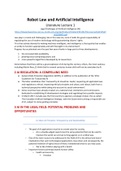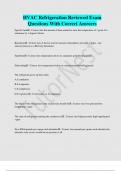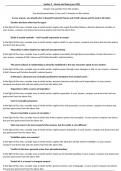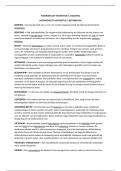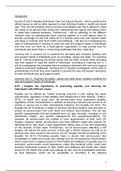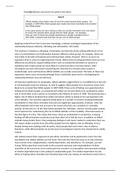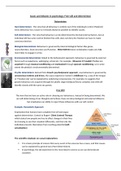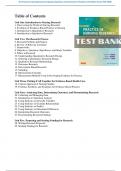Literature Lecture 1
Legal Challenges of Artificial Intelligence (AI)
https://kluwerlawonline-com.vu-nl.idm.oclc.org/api/Product/CitationPDFURL?file=Journals\GPLR\GP
LR2020003.pdf
Law plays a crucial and challenging role in this new era, since it holds the great responsibility of
regulating the use of modern technology while guaranteeing citizens’ rights.
‘AI is that activity devoted to making machines intelligent, and intelligence is that quality that enables
an entity to function appropriately and with foresight in its environment’
Progress has accelerated over the past few years thanks in large part to three developments:
1. the increased data availability,
2. growing cloud computing power, and
3. more powerful algorithms developed by AI researchers
Some believe that there will be a great explosion of AI during this century, others, the most cautious,
including Martin Rees,13 think that for several centuries human skills will not be overtaken by AI.
2 AI REGULATION: A COMPELLING NEED
● General Data Protection Regulation (GDPR), in addition to the publication of the ‘Ethic
Guidelines for Trustworthy AI
● The latter establishes that ‘trustworthy AI should be: lawful, respecting all applicable laws
and regulations; ethical, respecting ethical principles and values; and robust, both from a
technical perspective while taking into account its social environment’.
● Some countries have already created, at a national level, institutions and commissions
dedicated to establishing AI development strategies and regulating their possible impacts.
● In March 2017, Canada was the first country to approve a strategic AI plan, the so-called
‘Pan-Canadian Artificial Intelligence Strategy’, with the Government aiming a responsible use
of AI, subject to some guiding principles.`
3 AI IN THE LEGAL FIELD: POTENTIAL PROBLEMS AND
OPPORTUNITIES
3.1 Basic AI Principles: Transparency and Explainability
− The goal of AI applications must be to create value for society.
o AI is a double-edged sword since the same potential that can be used to
improve the world can end up turning against us in a lethal way.
− One of the main issues to be addressed in the field of AI is the ethical and moral
implications that such technological applications may entail, and consequently, the
potential violation of rights (most of them, fundamental) that its use may cause.
o We’re like children playing with a bomb
− Important factors pointing towards human safety:
o health and security
▪ freedom
, ▪ privacy
o integrity and dignity
▪ self-determination
▪ non-discrimination
▪ personal data protection
− In relation to the ethical and moral issue, it is convenient to bring up the three rules
of robotics – a discipline in which AI has had great influence-, qualified as
fundamental laws by Isaac Asimov, since they could be a good starting point in the
regulation of the subject matter:
o 1. A robot cannot harm a human being by its actions or its omissions.
o 2. A robot must obey the orders received by a human being, except if
such orders conflict with the first law.
o 3. A robot must protect its own existence as long as such protection
does not conflict with the first or second law.
− At present however, this is not entirely applicable in the field of AI, since we are in the
era of machine learning, in which programs are being created with the ability to learn
from themselves and, therefore, obedience to humans is going to be a little diffuse.
o On that basis, Stuart Russell, has pointed out that the main problem with AI
control is how to make sure that systems with an arbitrarily high degree of
intelligence remain under strict human control.
o With respect to the need to guarantee the rights at stake, special attention
should be given to the protection of human rights. Prior to analyzing what
rights may be threatened by the application of AI, it is essential to stress that
humans have the right to know, with absolute transparency and in an
understandable way, the basis on which the systems that use such
technology make the decisions that affect us.
o In order to detect the violation of a right, it is essential to know in advance
how the decision-making process works, because this is essential for AI
systems to gain the trust of citizens, and such trust is necessary for its
application to be useful and efficient.
▪ Unfortunately, most of the time, algorithmic decision-making
becomes synonymous with inexplicable decision making,32 which is
usually defined as a black box. This, without a doubt, breeds mistrust
towards AI and generates discomfort in society.
o It is necessary to record and document the entire decision-making process,
including a description of the means of obtaining the data used and its
labelling, as well as an explanation of the algorithm used in each case and the
degree to which it has influenced the decision-making.
▪ All in an understandable way for people who have no further
technical knowledge.
3.2 Risk of Human Rights Violations: The Devil Is in the Data
− One of the most controversial issues arising from AI is the possible bias in the
algorithms that could lead to discrimination and therefore to a violation of Article 2 of
the Universal Declaration of Human Rights
▪ It must be said that the use of quality data in AI systems is the most efficient
way to guarantee good results, since fundamental rights may be affected by
the use of low-quality data which can be either nonrepresentative
(unrepresentative with respect to certain groups in the population) or biased.
, − We must mention the systems CrimeScan and PredPol, which tend to predict where
crimes might occur.
− Prior to the use of AI, all judicial decisions were obviously made by judges, and since
they are human, and that every decision made by a human being is susceptible to
bias, the judicial system is inevitably fraught with biases.
▪ Although it could appear as though the use of algorithms would eliminate
biases, the truth is that algorithms incorporate the overall biases of all the
decisions on which they were based. Therefore, their multiplying power is
extremely dangerous.
− Although not yet implemented, the question of replacing the judge with an AI system
begins to emerge.
− Thus, we see that although certain AI tools are already being used by courts around
the world, it is of the essence to limit and regulate their use, since, the possibility of
having a greater influence on judges than desired is highly likely (as could be, for
example, the content of illegal evidence that the judge cannot officially assess but
knows unofficially).
3.3 A New Horizon for Lawyers
− It is important to show that the field of law is experiencing a true revolution that,
despite what some people may think, could be highly beneficial.
▪ AI has also been used for contract reviews, which are tasks that AI performs
faster and more precisely than humans
− Law firms have already started to work with AI tools, although there is a certain fear
in the sector of the possible loss of jobs that this may imply.
4 CONCLUSIONS
− It is said that ‘Data is the new oil’, and ‘AI is the new electricity’.
− It is crucial that policymakers take responsibility for ensuring that the enormous
potential of machines does not end up replacing and devastating us mercilessly.
− We must more than ever be well informed, and we must undoubtedly encourage new
generations working in the legal field to foster their capacity for adaptation and
constant renewal, because while the future is not written, we can definitely forecast
that it will be in constant movement.
, Artificial Intelligence as a Challenge for Law and Regulation
https://link-springer-com.vu-nl.idm.oclc.org/content/pdf/10.1007%2F978-3-030-32361-5_1.pdf
6 Obstacles to the Effective Application of Law
6.1 Openness to Development
❖ Stephen Hawking shared this concern. While acknowledging the tremendous potential of AI,
he called for increased focus on the issue of AI security.
❖ Very often warnings about the consequences of AI relate not just to specific applications but
also to the fundamental risk that AI could defy human control and develop destructive
potentials for humanity as a whole.
o The discussion of future risks focuses not just on the primarily ethical consequences
for human development and the concept of human intelligence and the way it
functions. There are also fears about new forms of cybercrime, such as the hacking of
pacemakers and other AI-controlled implants.
6.2 Insignificance of Borders
❖ Difficulties involving the legal treatment of complex information technology systems also
result from the fact that in many respects, technologies dissolve borders or demand action in
borderless areas.
❖ They are often available on a transnational and, in particular, global basis.
❖ The use of AI also takes place mostly in un bordered spaces.
❖ Large, globally positioned IT companies in particular are interested in operating as far as
possible with uniform structures that have a global or transnational reach. For these
companies, regulations that are set down in various national legal systems and accordingly
differ from one another constitute an impediment to the use of their business models. As a
result, they look for and exploit opportunities to thwart or avoid such regulations.
6.3 Lack of Transparency
❖ Even though it is possible to overcome the black-box character of information technology
systems,53 such as through reverse engineering, this normally presupposes a high level of
expertise and the use of complex procedures.
o Black box = when a part of AI algorithms outcomes are unknown to
everyone, cannot be explained.
❖ In this regard, sufficient transparency is a prerequisite for creating not only trust but also
accountability and, in some cases, liability.

